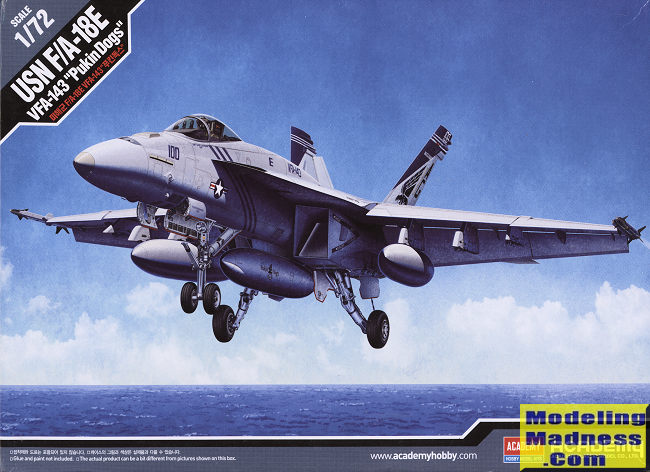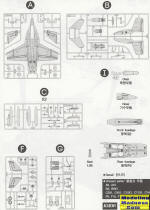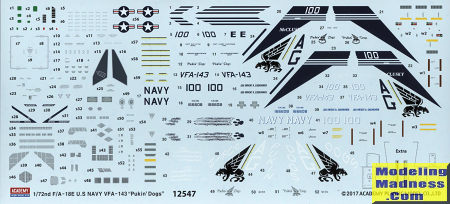
| KIT #: | 12547 |
| PRICE: | $24.00 shipped from Korea |
| DECALS: | Two options |
| REVIEWER: | Scott Van Aken |
| NOTES: | 2017 boxing |

| HISTORY |
The Boeing F/A-18E Super Hornet and related twin-seat F/A-18F are twin-engine carrier-capable multirole fighter aircraft variants based on the McDonnell Douglas F/A-18 Hornet. The F/A-18E single-seat and F/A-18F tandem-seat variants are larger and more advanced derivatives of the F/A-18C and D Hornet. The Super Hornet has an internal 20 mm M61 rotary cannon and can carry air-to-air missiles and air-to-surface weapons. Additional fuel can be carried in up to five external fuel tanks and the aircraft can be configured as an airborne tanker by adding an external air refueling system.
Designed and initially produced by McDonnell Douglas, the Super Hornet first flew in 1995. Full-rate production began in September 1997, after the merger of McDonnell Douglas and Boeing the previous month. The Super Hornet entered service with the United States Navy in 1999, replacing the Grumman F-14 Tomcat, which was retired in 2006; the Super Hornet serves alongside the original Hornet. The Royal Australian Air Force (RAAF), which has operated the F/A-18A as its main fighter since 1984, ordered the F/A-18F in 2007 to replace its aging F-111 fleet. RAAF Super Hornets entered service in December 2010.
In September 2014, Boeing readied plans to close its St. Louis production lines for the Super Hornet and F-15 in 2017. Not surprisingly, thanks to the constant delays with the F-35, the plant is still
| THE KIT |
 I
bought this kit as I'd been told that this is more up to date than the Hasegawa
super bug. Well, it does have the more recent protector grilles over the rear
deck intakes that the Hasegawa kit does not, so perhaps that would be a good
reason to choose this one.
I
bought this kit as I'd been told that this is more up to date than the Hasegawa
super bug. Well, it does have the more recent protector grilles over the rear
deck intakes that the Hasegawa kit does not, so perhaps that would be a good
reason to choose this one.
Interestingly, the kit starts you assembling the upper fuselage. This contains the upper wings and part of the lower. There are two lower wing/lerex pieces to put in place. There is a rear lower fuselage section that includes the main gear and the gear wells are a separate piece. You are also required to build up the engine intakes and install the landing gear legs prior to trapping the horizontal stab when attaching the upper and lower fuselage sections.
It is only then that you move on to the cockpit. This is the standard two seat tub with a two piece seat and control stick along with an instrument panel. There are five small decals to fit on the panel with one each for the side consoles. The lower forward fuselage also includes the nose gear well.
The nose is more than just the radome; basically everything forward of the lerex and a single piece. There is an insert for the upper fuselage behind the front seat that makes this an E model. There is a one-piece windscreen/canopy. To complete the airframe, you build up and install the nose gear, attach all the gear doors and the wheels.
A supplemental instruction sheet covers the
installation of the 'things under wings'. All the holes for attaching the pylons
are already open and quite large. This includes the fuselage centerline. If you
don't want a pylon, you'll need to fill holes. From the wing tip we have:
Sidewinder, AIM-120, Mk82 bombs, fuel tanks. A fuel tank is provided for the
centerline. The fuel tanks have the pylon molded to one tank half. I'm not ja zzed
about the AIM-120s being in three pieces.
zzed
about the AIM-120s being in three pieces.
Instructions are very nicely drawn and you have options for two planes from VFA-143. Actually, they are both the same plane, which is the CAG bird. One from the 14th of September 2014 with the blue tail and the other from the 20th of September 2014 with a more conventional greys CAG scheme. The decals look to be very nicely done and if you don't like that scheme, there are a ton of aftermarket options.
| CONCLUSIONS |
Well, I have to say that the parts breakdown is a bit unconventional for Hornets from other kit makers and only the building will tell if it is better or not. The large pylon attachment points will gain marks from many modelers as will the general simplification of the kit. Others won't like the pre-drilled holes or the one-piece canopy. Still, if super bugs in this scale are something you like building, then this is probably a good choice.
| REFERENCES |
Copyright ModelingMadness.com. All rights reserved.
If you would like your product reviewed fairly and fairly quickly, please contact the editor or see other details in the Note to Contributors.
Back to the Main Page Back to the Review Index Page Back to the Previews Index Page